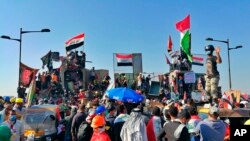ພວກປະທ້ວງຕໍ່ຕ້ານລັດຖະບານ ໄດ້ພາກັນປິດຖະໜົນຫົນທາງຫຼາຍສາຍ ແລະຫ້ອງການຂອງລັດຖະບານ ໃນນະຄອນຫຼວງແບັກແດດ ຂອງອີຣັກ ເມື່ອວັນອາທິດວານນີ້ ຊຶ່ງການໂຮມຊຸມນຸມປະທ້ວງທີ່ຮຽກຮ້ອງໃຫ້ມີການປ່ຽນແປງທາງການເມືອງ ທີ່ແກ່ຍາວມານຶ່ງເດືອນ ໄດ້ທະວີຄວາມຮຸນແຮງຂຶ້ນ.
ເມື່ອສອງສາມວັນຜ່ານມານີ້ ພວກປະທ້ວງຫຼາຍສິບພັນຄົນ ໄດ້ເຕົ້າໂຮມກັນຢູ່ທີ່ຈະຕຸລັດ ຕາຣີຣ (Tahrir) ໃນນະຄອນຫຼວງແບັກແດດ ແລະຢູ່ທົ່ວພາກໃຕ້ຂອງອີຣັກ ໂດຍເຮັດໃຫ້ຕະຫຼາດຫຼາຍແຫ່ງ ໂຮງຈັກໂຮງງານ ໂຮງຮຽນ ແລະມະຫາວິທະຍາໄລ ທັງຫຼາຍຕ້ອງປິດລົງ ໃນການປະທ້ວງຕໍ່ລະບົບການເມືອງທີ່ໄດ້ຖືກຈັດຕັ້ງຂຶ້ນ ນັບຕັ້ງແຕ່ປີ 2003 ຫຼັງຈາກການບຸກລຸກເຂົ້າໃນປະເທດ ທີ່ນຳພາໂດຍສະຫະລັດ ຊຶ່ງໄດ້ໂຄ່ນລົ້ມຈອມຜະເດັດການ ຊັດດາມ ຮຸສເຊນ.
ນາຍົກລັດຖະມົນຕີ ອາແດລ ອັບດູລ-ມາດີ ໄດ້ຮຽກຮ້ອງໃຫ້ສະຖານທີ່ແຫ່ງຕ່າງໆທີ່ປິດລົງ ໃຫ້ເປີດຄືນໃໝ່ ໂດຍໃຫ້ເຫດຜົນວ່າ ເປັນໄພຂົ່ມຂູ່ຕໍ່ບໍ່ນ້ຳມັນ ແລະການປິດຫົນທາງ ໄດ້ສ້າງຄວາມເສຍຫາຍຕໍ່ອີຣັກ “ຫຼາຍລ້ານ” ໂດລາ ແລະສົ່ງຜົນໃຫ້ລາຄາເຄື່ອງບໍລິໂພກໃນປະເທດສູງຂຶ້ນ.
ຜູ້ນຳຂອງອີຣັກ ໄດ້ກ່າວວ່າ “ມັນເຖິງເວລາແລ້ວ ທີ່ຊີວິດການເປັນຢູ່ ຄວນກັບຄືນສູ່ປົກກະຕິ.”
ພວກນັກສຶກສາຫຼາຍພັນຄົນ ໄດ້ພາກັນບໍ່ໄປຮ່ຳຮຽນ ເພື່ອເຂົ້າຮ່ວມໃນການປະທ້ວງ ພວກເຂົາຖິ້ມໂທດໃສ່ບັນດາຜູ້ນຳຂອງປະເທດ ສຳລັບການສໍ້ລາດບັງຫຼວງທີ່ມີຢ່າງແຜ່ຫຼາຍ ການຫວ່າງງານທີ່ສູງຂຶ້ນ ແລະບໍລິການດ້ານສາທາລະນະທີ່ຂີ້ຮ້າຍ. ບັນດາກຸ່ມຄະນະເຊັ່ນ ນັກວິສະວະກອນ ທ່ານໝໍ ແລະທະນາຍຄວາມທັງຫຼາຍ ກໍໄດ້ໃຫ້ການສະໜັບສະໜຸນ ຕໍ່ການປະທ້ວງດັ່ງກ່າວ.
ພວກປະທ້ວງໃນວັນອາທິດວານນີ້ ໄດ້ພາກັນກີດກັ້ນທະໜົນຫົນທາງຫຼາຍສາຍ ໃນບໍລິເວນອ້ອມແອ້ມສະຖານທີ່ປະທ້ວງທີ່ສຳຄັນ ດ້ວຍການຈູດຢາງລົດ ແລະໃຊ້ລວດໜາມໝາກຈັບ. ຢູ່ບ່ອນກີດກັ້ນທາງແຫ່ງນຶ່ງ ພວກປະທ້ວງໄດ້ກາງປ້າຍໂຄສະນາ ທີ່ກ່າວວ່າ “ທາງປິດຍ້ອນຄຳສັ່ງຂອງປະຊາຊົນ.”
ນັບຕັ້ງແຕ່ຕົ້ນເດືອນຕຸລາ ກຳລັງຮັກສາຄວາມສະຫງົບ ໄດ້ຍິງແກັສນ້ຳຕາລະດັບຂອງທະຫານ ລູກປືນຢາງ ແລະລູກປືນແທ້ ເຂົ້າໃສ່ພວກປະທ້ວງ ແລະໄດ້ສັງຫານປະຊາຊົນຢ່າງໜ້ອຍ 256 ຄົນ. ຫຼັງຈາກທີ່ໄດ້ຢຸດເຊົາລົງໄລຍະບໍ່ດົນ ການປະທ້ວງກໍໄດ້ເລີ້ມຂຶ້ນອີກ ໃນວັນທີ 25 ຕຸລາ ໂດຍມີການປະທະກັນຢູ່ເລື້ອຍໆ ເທິງຂົວສອງແຫ່ງ ທີ່ນຳໄປສູ່ເຂດສີຂຽວ ທີ່ມີການຄຸມກັນຢ່າງໜາແໜ້ນ ຊຶ່ງເປັນເຂດສຳນັກງານຂອງລັດຖະບານ ແລະເປັນທີ່ຕັ້ງຂອງບັນດາສະຖານທູດຂອງຕ່າງປະເທດ.
ລັດຖະບານອີຣັກ ໄດ້ສະເໜີການປະຕິຮູບຫຼາຍຮອບຜ່ານມາ ທີ່ປະກອບດ້ວຍ ການສ້າງວຽກເຮັດງານທຳຫຼາຍຂຶ້ນ ແລະ ແຜນການສະຫວັດດີການສັງຄົມ ພ້ອມດ້ວຍ ການເລືອກຕັ້ງກ່ອນກຳນົດ ເມື່ອໃດທີ່ກົດໝາຍວ່າດ້ວຍການປ່ອນບັດອອກສຽງສະບັບໃໝ່ ໄດ້ຖືກຮັບຮອງ.
ແຕ່ພວກປະທ້ວງ ກໍຍັງສືບຕໍ່ທ້າທາຍລັດຖະບານ.
ທ່ານໂມຮຳມັດ ອາລ-ອາສຊາດີ ລັດຖະກອນຜູ້ທີ່ເຂົ້າຮ່ວມໃນການປະທ້ວງຢູ່ໃນເມືອງ ນາຊີຣີຢາ ທາງພາກໃຕ້ຂອງປະເທດ ໄດ້ກ່າວຕໍ່ ອົງການຂ່າວຝຣັ່ງ ຫຼື AFP ວ່າ “ພວກເຮົາໄດ້ຕັດສິນໃຈ ທີ່ຈະຂັດຂືນຕໍ່ຄຳສັ່ງຂອງທາງການ ຍ້ອນວ່າ ພວກເຮົາພໍແລ້ວກັບການຕົວະຕົ້ມ ແລະການໃຫ້ຄຳໝັ້ນສັນຕໍ່ອັນທີ່ເອີ້ນວ່າ ການປະຕິຮູບຂອງລັດຖະບານນັ້ນ.”
Anti-government protesters in Baghdad shut down roads and government offices in the Iraqi capital on Sunday, escalating a month-long string of rallies demanding political change.
Tens of thousands of demonstrators have gathered in recent days in Baghdad's Tahrir Square and across southern Iraq, shutting down markets, factories, schools and universities in protest of the political system in place since the 2003 U.S.-led invasion that toppled dictator Saddam Hussein.
Prime Minister Adel Abdul-Mahdi called for the shuttered places to be reopened, contending that the threat to oil facilities and closure of roads had cost Iraq "millions" of dollars and contributed to consumer price increases in the country.
"It's time for life to return to normal," the Iraqi leader said.
Thousands of students have skipped classes to join the protests, blaming the country's leaders for rampant corruption, high unemployment and poor public services. Syndicates of engineers, doctors and lawyers have all backed the protests.
The protesters on Sunday blocked roads around the main protest site with burning tires and barbed wire. At one roadblock, the demonstrators unfurled a banner saying, "Roads closed by order of the people."
Since early October, security forces have fired military-grade tear gas, rubber bullets and live ammunition at the protesters, killing at least 256 people. After a brief hiatus, the protests restarted again Oct. 25, with frequent clashes on two bridges leading to the heavily-fortified Green Zone, the headquarters of the government and home to several foreign embassies.
The government has proposed a string of reforms, including more jobs and social welfare plans, along with early elections once a new voting law is adopted.
But the protesters have continued to challenge the government.
"We decided on this campaign of civil disobedience because we have had it up to here with the government's lies and promises of so-called reform," Mohammad al-Assadi, a government employee on strike in the southern city of Nasiriyah, told Agence France Presse.
The protests are leaderless, without an organizational structure, and they are not unified.
However, they have drawn a wide swath of the population from across the country's sectarian and ethnic divides.
A move in Iraq's parliament to approve a bill to cancel privileges and bonuses for senior politicians, including the president, prime minister and Cabinet ministers, has done little to calm the marchers.










